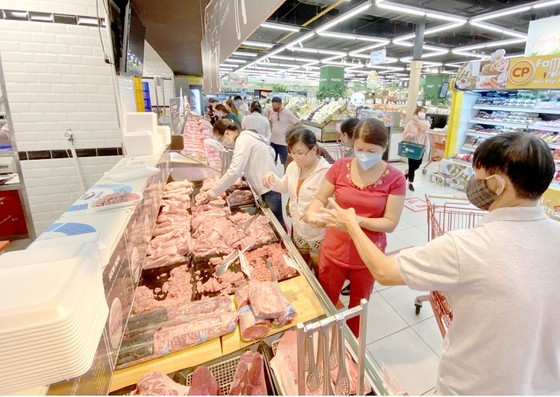
However, the increase in consumer promotions also did not manage to pull up the purchasing power that went down quickly and deeply because of consumers’ spending cuts in the context of the complicated developments of the Covid-19 pandemic. Noticeably, in the first seven months of this year, the consumer structure and mentality have had changes in a negative direction.
Visiting shopping malls in Ho Chi Minh City during this time, many people share the same feeling that sellers outnumber buyers, although several domestic and international brands are still offering to reduce their prices by up to 50 percent. In many retail markets, most of the non-food stalls have stopped selling because there are no customers, only the fresh food sector is still active.
At supermarkets, the situation is better because many customers come to shop, but the purchasing power is not as strong as before, but only focuses on the groups of food and foodstuffs for daily needs. According to the MM Mega Market's preliminary statistics, the purchasing power of this commodity group increased by about 6 percent-7 percent on average. In groups of non-food products, such as kitchen appliances, household appliances, clothes, and shoes, the purchasing power dropped sharply compared to the same period.
At the retail network of the Saigon Co.op, according to the calculations of Mr. Do Quoc Huy, Marketing Director, the purchasing power of the whole network has decreased by about 10 percent at this time, of which, the purchasing power at supermarkets located in 43 provinces and cities weakened dramatically for many reasons.
The report on the situation of industrial production, trade, and import-export activities in Ho Chi Minh City showed that the total retail sales of consumer goods and services in July was estimated at more than VND104.06 trillion, down 5.8 percent compared to the same period last year, of which, trade increased by 2.0 percent; accommodation and catering services fell by 36.1 percent; travel services plummeted by 95.5 percent; other services slid 4.4 percent. In the first seven months of this year, trade and service revenue was estimated at above VND718.13 trillion, down 3.8 percent. In which, retail sales of goods - the only industry with growth in service industries - in the first seven months was estimated at more than VND463.44 trillion dong, up 8.2 percent, accounting for 64.5 percent in total retail sales of goods and service revenue.
According to a market researcher, the purchasing power was affected by the recurrence of the Covid-19 pandemic. At this time, it is not much, but in the next quarter, the situation may be more serious. The main reason comes from the continuously increasing concerns over job losses from April to June in Vietnam, mainly occurring in the sectors of private and FDI enterprises, and people with incomes below VND20 million per month. More than 30 percent of people in this group expressed fear of losing their jobs.
With such a mentality, 90 percent of people in this group have immediately tightened their spending. The average percentage of spending has been cut continuously since April. Not only households reduce spending, but the unmarried young people in the 8X and 9X generation groups with a decent income, also share this mentality. Belt-tightening dominated quite clearly, making it difficult for the general purchasing power in the market to increase as high as traders’ expectations.
Ms. Tran Phuong Thao, an accountant of a telecommunications company in Binh Thanh District, said that since the outbreak of the Covid-19 pandemic, she and her husband have taken turns hunting promotional products at supermarkets or fairs to save costs for their family. From clothes to household utensils, especially essential items like fresh and processed foods, they have always waited for promotions to buy. Besides, consumer habits have also changed from only buying products manufactured by enterprises to buying private-label products of supermarkets.
According to Ms. Thao's calculations, sometimes, private-label products under various promotion programs will be cheaper by 25-30 percent than those of enterprises. For example, a 500-gram dry vermicelli pack of Co-op Select - Saigon Co-op's private-label brand - costs VND18,500, only equal to two-thirds of the selling price of dry vermicelli of Safoco, whose a 400-gram dry vermicelli pack is priced from VND23,500 to VND95,000, depending on the point of sale.
"When using, maybe I like the vermicelli a bit dry and you like the vermicelli to be a little softer, but if I trust the distributor and the product has a cheaper price, then at this moment I give priority to private-label brands", said Mrs. Thao.
The analysis of the market consulting group under the Business Studies & Assistance Center (BSA) shows that the vast majority of product lines usually have three segments, including the low-cost segment which accounts for 5-20 percent, the average price segment which accounts for 50-70 percent, and the high-end segment which accounts for 10-15 percent. The rest was the super-cheap segment. This segment is the group of products with no brand name and weak brand names, in which consumers only care about products with low prices and acceptable quality. During the three months of the second quarter of this year, the market witnessed the explosive growth of this group. Several fast-moving consumer goods lines have seen 3-digit growth in both urban and rural areas. Moreover, the low-cost segment has also posted a fairly encouraging increase level of 10-30 percent, depending on each product line.
Noticeably, the consumption volume did not increase, but even decreased, because consumers have only shifted strongly from the upper segments to the two lower groups. This makes enterprises more concerned than happy because this is a trend that will make the product lines decline in value.
The Deputy CEO in charge of procurement of a supermarket chain in Ho Chi Minh City shared the same opinion, in most product groups, if there are no promotions in different ways, they will not be salable. Customers have never paid close attention to the selling price of the product as currently. This fact has sent enterprises into a constant race to reduce selling prices, or even selling without profits to attract customers. As for domestic manufacturing enterprises, especially small and medium-sized enterprises, it is difficult for startups to compete with large enterprises or global brands.
Visiting shopping malls in Ho Chi Minh City during this time, many people share the same feeling that sellers outnumber buyers, although several domestic and international brands are still offering to reduce their prices by up to 50 percent. In many retail markets, most of the non-food stalls have stopped selling because there are no customers, only the fresh food sector is still active.
At supermarkets, the situation is better because many customers come to shop, but the purchasing power is not as strong as before, but only focuses on the groups of food and foodstuffs for daily needs. According to the MM Mega Market's preliminary statistics, the purchasing power of this commodity group increased by about 6 percent-7 percent on average. In groups of non-food products, such as kitchen appliances, household appliances, clothes, and shoes, the purchasing power dropped sharply compared to the same period.
At the retail network of the Saigon Co.op, according to the calculations of Mr. Do Quoc Huy, Marketing Director, the purchasing power of the whole network has decreased by about 10 percent at this time, of which, the purchasing power at supermarkets located in 43 provinces and cities weakened dramatically for many reasons.
The report on the situation of industrial production, trade, and import-export activities in Ho Chi Minh City showed that the total retail sales of consumer goods and services in July was estimated at more than VND104.06 trillion, down 5.8 percent compared to the same period last year, of which, trade increased by 2.0 percent; accommodation and catering services fell by 36.1 percent; travel services plummeted by 95.5 percent; other services slid 4.4 percent. In the first seven months of this year, trade and service revenue was estimated at above VND718.13 trillion, down 3.8 percent. In which, retail sales of goods - the only industry with growth in service industries - in the first seven months was estimated at more than VND463.44 trillion dong, up 8.2 percent, accounting for 64.5 percent in total retail sales of goods and service revenue.
According to a market researcher, the purchasing power was affected by the recurrence of the Covid-19 pandemic. At this time, it is not much, but in the next quarter, the situation may be more serious. The main reason comes from the continuously increasing concerns over job losses from April to June in Vietnam, mainly occurring in the sectors of private and FDI enterprises, and people with incomes below VND20 million per month. More than 30 percent of people in this group expressed fear of losing their jobs.
With such a mentality, 90 percent of people in this group have immediately tightened their spending. The average percentage of spending has been cut continuously since April. Not only households reduce spending, but the unmarried young people in the 8X and 9X generation groups with a decent income, also share this mentality. Belt-tightening dominated quite clearly, making it difficult for the general purchasing power in the market to increase as high as traders’ expectations.
Ms. Tran Phuong Thao, an accountant of a telecommunications company in Binh Thanh District, said that since the outbreak of the Covid-19 pandemic, she and her husband have taken turns hunting promotional products at supermarkets or fairs to save costs for their family. From clothes to household utensils, especially essential items like fresh and processed foods, they have always waited for promotions to buy. Besides, consumer habits have also changed from only buying products manufactured by enterprises to buying private-label products of supermarkets.
According to Ms. Thao's calculations, sometimes, private-label products under various promotion programs will be cheaper by 25-30 percent than those of enterprises. For example, a 500-gram dry vermicelli pack of Co-op Select - Saigon Co-op's private-label brand - costs VND18,500, only equal to two-thirds of the selling price of dry vermicelli of Safoco, whose a 400-gram dry vermicelli pack is priced from VND23,500 to VND95,000, depending on the point of sale.
"When using, maybe I like the vermicelli a bit dry and you like the vermicelli to be a little softer, but if I trust the distributor and the product has a cheaper price, then at this moment I give priority to private-label brands", said Mrs. Thao.
The analysis of the market consulting group under the Business Studies & Assistance Center (BSA) shows that the vast majority of product lines usually have three segments, including the low-cost segment which accounts for 5-20 percent, the average price segment which accounts for 50-70 percent, and the high-end segment which accounts for 10-15 percent. The rest was the super-cheap segment. This segment is the group of products with no brand name and weak brand names, in which consumers only care about products with low prices and acceptable quality. During the three months of the second quarter of this year, the market witnessed the explosive growth of this group. Several fast-moving consumer goods lines have seen 3-digit growth in both urban and rural areas. Moreover, the low-cost segment has also posted a fairly encouraging increase level of 10-30 percent, depending on each product line.
Noticeably, the consumption volume did not increase, but even decreased, because consumers have only shifted strongly from the upper segments to the two lower groups. This makes enterprises more concerned than happy because this is a trend that will make the product lines decline in value.
The Deputy CEO in charge of procurement of a supermarket chain in Ho Chi Minh City shared the same opinion, in most product groups, if there are no promotions in different ways, they will not be salable. Customers have never paid close attention to the selling price of the product as currently. This fact has sent enterprises into a constant race to reduce selling prices, or even selling without profits to attract customers. As for domestic manufacturing enterprises, especially small and medium-sized enterprises, it is difficult for startups to compete with large enterprises or global brands.
























